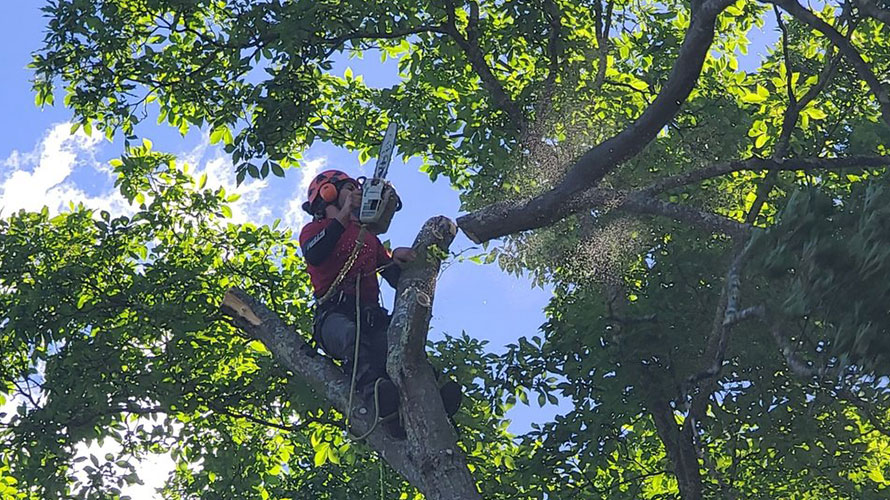You love your big, old tree. But you worry it might split in a storm or drop a heavy limb. You’re asking: “Can tree cabling protect my mature tree and keep my yard safe?”
Tree cabling can:
- Support weak limbs
- Reduce breakage in storms
- Extend a tree’s safe life
- Protect people and property
- Work with pruning for the best results
In this guide, we’ll explain what cabling is, when it helps, how it works, and what it costs. We’ll also cover risks, upkeep, and how to pick the right arborist. Simple steps, clear answers.
What is tree cabling?
Tree cabling uses strong steel or synthetic lines to connect limbs or the trunk to limbs.
The goal is to share the load. Instead of one weak branch taking all the stress, the cable spreads it out.
Why cabling helps mature trees
Big trees face heavy wind, snow, and limb weight. Old growth can be strong but also stressed.
Cabling helps by limiting how much high limbs can move. Less movement means less chance of a split.
Info: Cabling does not “fix” a defect. It manages risk. It works best with smart pruning and regular checks.
When cabling makes sense
Cabling is not for every tree. Here are common signs that it might help.
- Co-dominant stems (two main trunks) with a “V” shape and bark pinched inside
- Long, heavy limbs growing out to one side
- Past cracks that were pruned but still worry you
- Trees in windy spots or near driveways, patios, or play areas
Quick Tip: If you see a tight “V” where two big stems meet, call a certified arborist. That “V” often means weak wood inside.
Signs you might need pruning instead
Sometimes, pruning alone solves the problem. Thinning and end-weight reduction remove stress at the tips of heavy branches.
If limbs are small or only a little heavy, a careful prune plan may be enough.
Suggestion: Ask your arborist for a “prune-first” approach. Cable only if the risk still feels high after pruning.
Types of cabling systems
There are two main kinds you’ll hear about.
- Static (steel) systems
Steel cables are sturdy and limit movement a lot. They are great for big, heavy limbs that need firm support.
They need hardware installed in the wood and must be inspected often.
- Dynamic (synthetic) systems
Synthetic systems allow gentle movement. This can help the tree build strength over time.
They are lighter and easier to install high in the canopy.
How the process works
Step 1: inspection
A certified arborist looks for weak forks, cracks, included bark, decay, and old wounds. They may use a mallet, drill, or sonic tools to check wood strength.
Step 2: plan
They pick anchor points and decide steel vs. synthetic. They’ll also set the number of cables and any extra support rods (called brace rods) if needed.
Step 3: install
For steel systems, they drill and set lag hooks or eye bolts, then run the cable and tension it.
For synthetic systems, they loop webbing or rope-like material around limbs and secure it per specs.
Step 4: prune
They reduce weight where needed. This makes the cable’s job easier and safer.
Step 5: document and schedule checkups
They note hardware type, placement height, and tension. Then they set an inspection schedule.
Table: cabling vs. other options
Here’s a quick way to compare common choices.
| Situation | Best first step | When to add cables | When to skip cables |
| Two big stems, tight “V” | Reduce weight with pruning | If risk remains due to weak union | If decay is advanced or stems already splitting |
| One heavy limb over driveway | End-weight reduction | When limb still feels risky after pruning | If limb has deep cracks or rot |
| Storm-prone area, older tree | Structural prune | To limit sway of key limbs | If the whole tree leans and roots are loose |
| Historic or high-value tree | Careful risk assessment | To preserve form while lowering risk | If removal is the only safe option |
Risks and limits you should know
Cabling reduces risk. It does not remove it.
Wood around hardware can change. Trees grow, so anchors can shift. That’s why regular checks matter.
If you see fresh cracks, sudden droop, or metal pulling out of the wood, stay clear and call an arborist at once.
Cost, timing, and maintenance
Costs vary by tree size, height, and number of cables. Expect more cost for crane access or hard-to-reach spots.
Plan on inspections every 1–3 years. After major storms, get a quick check.
Many insurers care about risk reduction. Keep your inspection records. They show you’re acting responsibly.
What happens if you skip cabling?
Some trees do fine. Others fail at weak points. A heavy limb can fall, split the trunk, or tear large wounds.
Once a major split happens, the tree may need large pruning or removal.
Care after cabling
Water during drought. Mulch with a 2–3 inch layer, kept away from the trunk. Avoid soil compaction under the canopy.
Keep up with pruning. Small, regular cuts are better than big cuts later.
Quick Tip: Ask for photos of the installed system and exact locations. This helps future checks go faster.
Summary
Tree cabling is a support system that helps hold weak or heavy limbs on mature trees. It lowers the chance of breaks, especially in storms, and works best with smart pruning and regular checks. Short answer: Yes, cabling can protect a mature tree when used in the right spots and inspected over time. If you need help, New View Tree Care is a solid choice for tree cabling service. They can assess your tree, prune what’s needed, install the right support, and set an inspection plan.

